fuse CADILLAC DTS PROFESSIONAL 2007 1.G Owners Manual
[x] Cancel search | Manufacturer: CADILLAC, Model Year: 2007, Model line: DTS PROFESSIONAL, Model: CADILLAC DTS PROFESSIONAL 2007 1.GPages: 518, PDF Size: 2.77 MB
Page 114 of 518
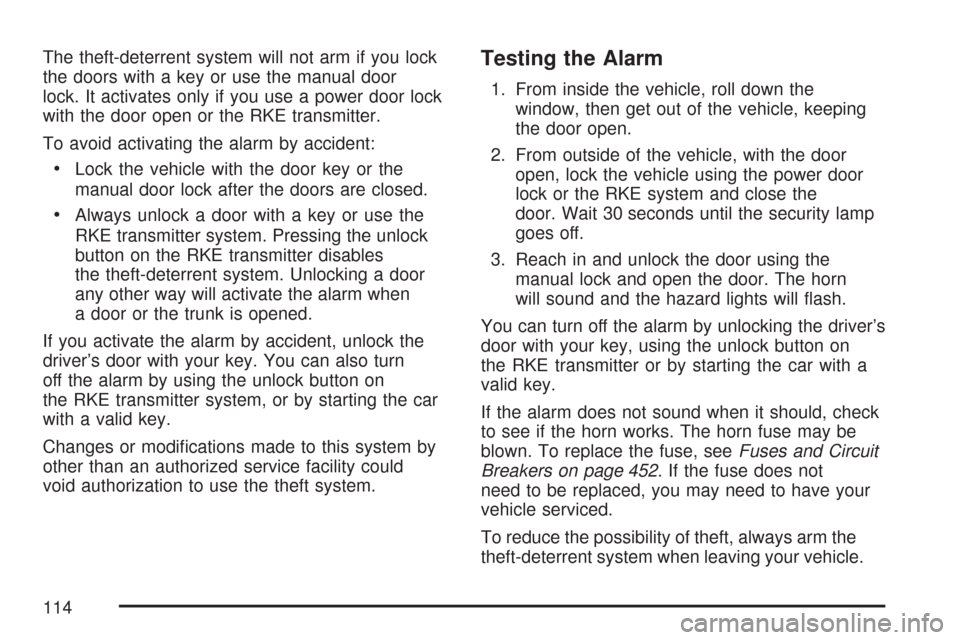
The theft-deterrent system will not arm if you lock
the doors with a key or use the manual door
lock. It activates only if you use a power door lock
with the door open or the RKE transmitter.
To avoid activating the alarm by accident:
Lock the vehicle with the door key or the
manual door lock after the doors are closed.
Always unlock a door with a key or use the
RKE transmitter system. Pressing the unlock
button on the RKE transmitter disables
the theft-deterrent system. Unlocking a door
any other way will activate the alarm when
a door or the trunk is opened.
If you activate the alarm by accident, unlock the
driver’s door with your key. You can also turn
off the alarm by using the unlock button on
the RKE transmitter system, or by starting the car
with a valid key.
Changes or modi�cations made to this system by
other than an authorized service facility could
void authorization to use the theft system.
Testing the Alarm
1. From inside the vehicle, roll down the
window, then get out of the vehicle, keeping
the door open.
2. From outside of the vehicle, with the door
open, lock the vehicle using the power door
lock or the RKE system and close the
door. Wait 30 seconds until the security lamp
goes off.
3. Reach in and unlock the door using the
manual lock and open the door. The horn
will sound and the hazard lights will �ash.
You can turn off the alarm by unlocking the driver’s
door with your key, using the unlock button on
the RKE transmitter or by starting the car with a
valid key.
If the alarm does not sound when it should, check
to see if the horn works. The horn fuse may be
blown. To replace the fuse, seeFuses and Circuit
Breakers on page 452. If the fuse does not
need to be replaced, you may need to have your
vehicle serviced.
To reduce the possibility of theft, always arm the
theft-deterrent system when leaving your vehicle.
114
Page 116 of 518
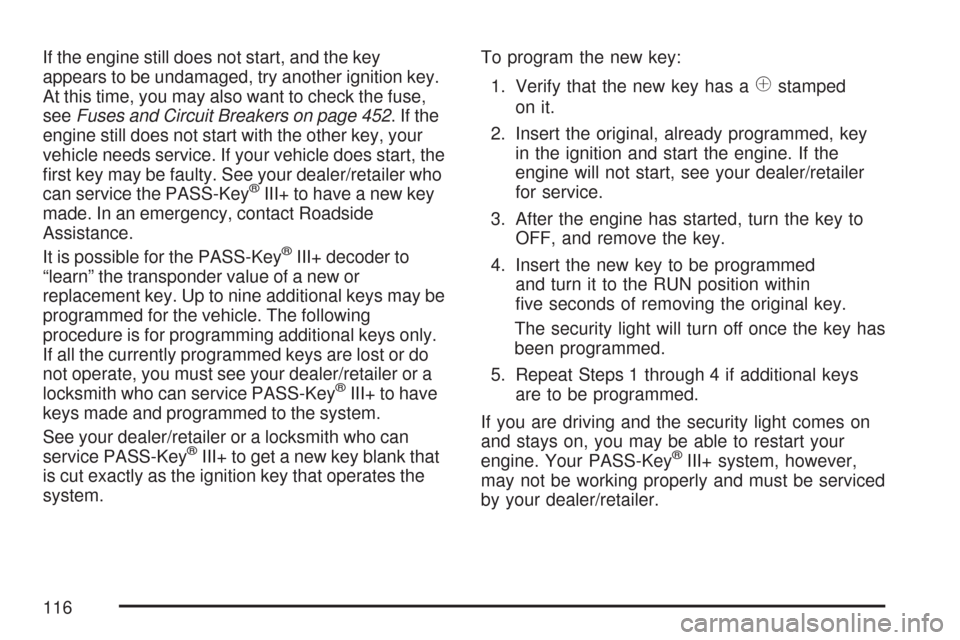
If the engine still does not start, and the key
appears to be undamaged, try another ignition key.
At this time, you may also want to check the fuse,
seeFuses and Circuit Breakers on page 452.Ifthe
engine still does not start with the other key, your
vehicle needs service. If your vehicle does start, the
�rst key may be faulty. See your dealer/retailer who
can service the PASS-Key
®III+ to have a new key
made. In an emergency, contact Roadside
Assistance.
It is possible for the PASS-Key
®III+ decoder to
“learn” the transponder value of a new or
replacement key. Up to nine additional keys may be
programmed for the vehicle. The following
procedure is for programming additional keys only.
If all the currently programmed keys are lost or do
not operate, you must see your dealer/retailer or a
locksmith who can service PASS-Key
®III+ to have
keys made and programmed to the system.
See your dealer/retailer or a locksmith who can
service PASS-Key
®III+ to get a new key blank that
is cut exactly as the ignition key that operates the
system.To program the new key:
1. Verify that the new key has a
1stamped
on it.
2. Insert the original, already programmed, key
in the ignition and start the engine. If the
engine will not start, see your dealer/retailer
for service.
3. After the engine has started, turn the key to
OFF, and remove the key.
4. Insert the new key to be programmed
and turn it to the RUN position within
�ve seconds of removing the original key.
The security light will turn off once the key has
been programmed.
5. Repeat Steps 1 through 4 if additional keys
are to be programmed.
If you are driving and the security light comes on
and stays on, you may be able to restart your
engine. Your PASS-Key
®III+ system, however,
may not be working properly and must be serviced
by your dealer/retailer.
116
Page 167 of 518

Turn and Lane-Change Signals
To signal a turn, move the lever all the way up
or down. The lever returns automatically when the
turn is complete. If you momentarily press and
release the lever, the turn signal will �ash 3 times.
An arrow on the
instrument panel
cluster and in the
outside rearview
mirror will �ash in the
direction of the turn
or lane change.
Raise or lower the lever until the arrow starts to
�ash to signal a lane change. Hold it there until
the lane change is complete. The lever returns
when it is released.
If the turn signal is left on, a warning chime will
sound and the Driver Information Center (DIC) will
display TURN SIGNAL ON after driving about a
mile to remind you to turn it off. SeeDIC Warnings
and Messages on page 246.Arrows that �ash rapidly when signaling for a
turn or lane change may be caused by a burned
out signal bulb. Other drivers will not see the
turn signal.
Replace burned-out bulbs to help avoid possible
accidents. Check the fuse and for burned-out bulbs
if the arrow fails to work when signaling a turn.
SeeRear Underseat Fuse Block on page 455.
Headlamp High/Low-Beam Changer
Push forward to change the headlamps from
low beam to high. Pull the lever back and then
release it to change from high beam to low.
This light on the
instrument panel cluster
will be on, indicating
high-beam usage.
167
Page 208 of 518
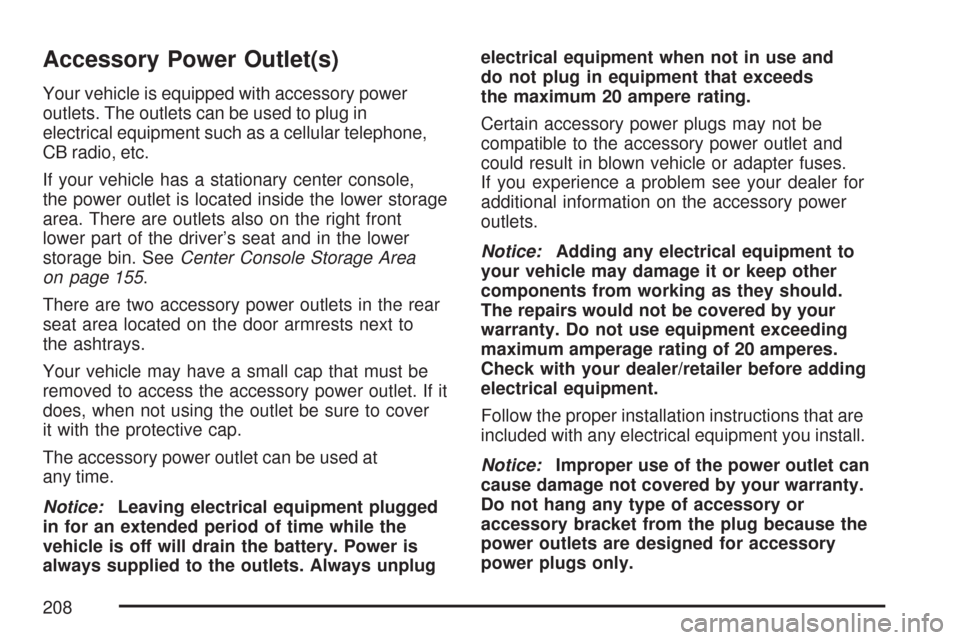
Accessory Power Outlet(s)
Your vehicle is equipped with accessory power
outlets. The outlets can be used to plug in
electrical equipment such as a cellular telephone,
CB radio, etc.
If your vehicle has a stationary center console,
the power outlet is located inside the lower storage
area. There are outlets also on the right front
lower part of the driver’s seat and in the lower
storage bin. SeeCenter Console Storage Area
on page 155.
There are two accessory power outlets in the rear
seat area located on the door armrests next to
the ashtrays.
Your vehicle may have a small cap that must be
removed to access the accessory power outlet. If it
does, when not using the outlet be sure to cover
it with the protective cap.
The accessory power outlet can be used at
any time.
Notice:Leaving electrical equipment plugged
in for an extended period of time while the
vehicle is off will drain the battery. Power is
always supplied to the outlets. Always unplugelectrical equipment when not in use and
do not plug in equipment that exceeds
the maximum 20 ampere rating.
Certain accessory power plugs may not be
compatible to the accessory power outlet and
could result in blown vehicle or adapter fuses.
If you experience a problem see your dealer for
additional information on the accessory power
outlets.
Notice:Adding any electrical equipment to
your vehicle may damage it or keep other
components from working as they should.
The repairs would not be covered by your
warranty. Do not use equipment exceeding
maximum amperage rating of 20 amperes.
Check with your dealer/retailer before adding
electrical equipment.
Follow the proper installation instructions that are
included with any electrical equipment you install.
Notice:Improper use of the power outlet can
cause damage not covered by your warranty.
Do not hang any type of accessory or
accessory bracket from the plug because the
power outlets are designed for accessory
power plugs only.
208
Page 209 of 518
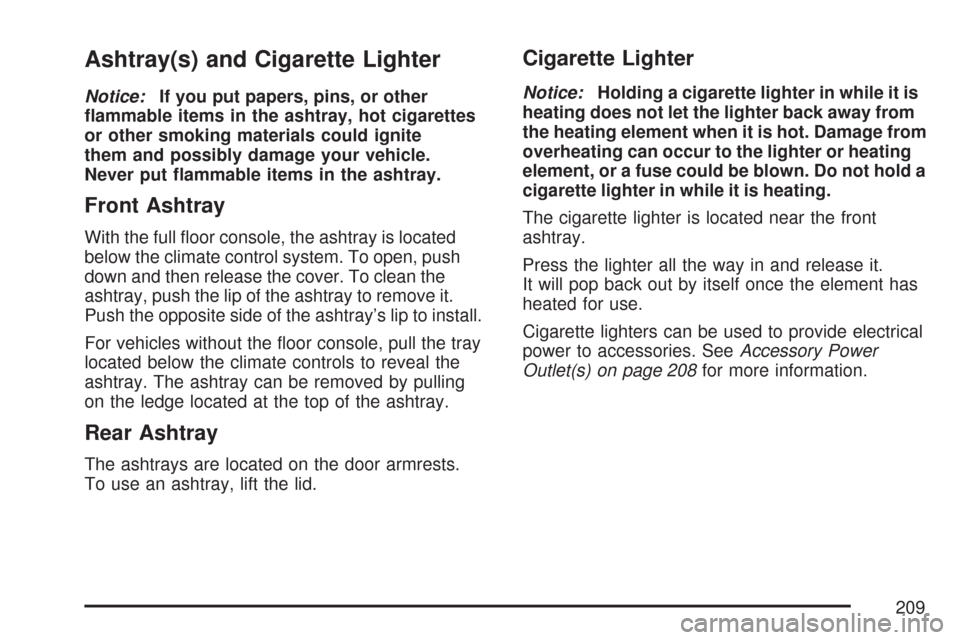
Ashtray(s) and Cigarette Lighter
Notice:If you put papers, pins, or other
�ammable items in the ashtray, hot cigarettes
or other smoking materials could ignite
them and possibly damage your vehicle.
Never put �ammable items in the ashtray.
Front Ashtray
With the full �oor console, the ashtray is located
below the climate control system. To open, push
down and then release the cover. To clean the
ashtray, push the lip of the ashtray to remove it.
Push the opposite side of the ashtray’s lip to install.
For vehicles without the �oor console, pull the tray
located below the climate controls to reveal the
ashtray. The ashtray can be removed by pulling
on the ledge located at the top of the ashtray.
Rear Ashtray
The ashtrays are located on the door armrests.
To use an ashtray, lift the lid.
Cigarette Lighter
Notice:Holding a cigarette lighter in while it is
heating does not let the lighter back away from
the heating element when it is hot. Damage from
overheating can occur to the lighter or heating
element, or a fuse could be blown. Do not hold a
cigarette lighter in while it is heating.
The cigarette lighter is located near the front
ashtray.
Press the lighter all the way in and release it.
It will pop back out by itself once the element has
heated for use.
Cigarette lighters can be used to provide electrical
power to accessories. SeeAccessory Power
Outlet(s) on page 208for more information.
209
Page 352 of 518
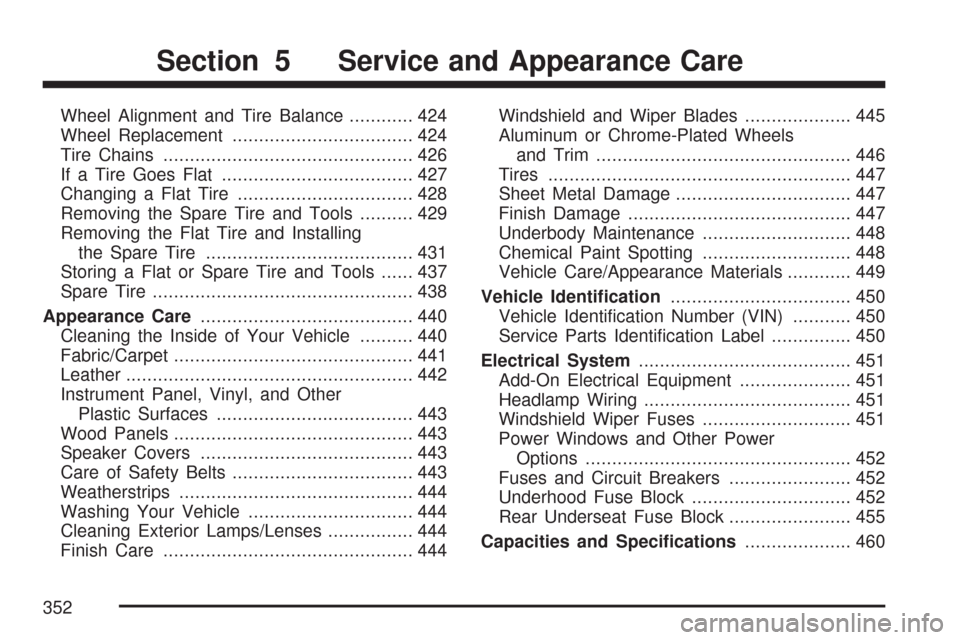
Wheel Alignment and Tire Balance............ 424
Wheel Replacement.................................. 424
Tire Chains............................................... 426
If a Tire Goes Flat.................................... 427
Changing a Flat Tire................................. 428
Removing the Spare Tire and Tools.......... 429
Removing the Flat Tire and Installing
the Spare Tire....................................... 431
Storing a Flat or Spare Tire and Tools...... 437
Spare Tire................................................. 438
Appearance Care........................................ 440
Cleaning the Inside of Your Vehicle.......... 440
Fabric/Carpet............................................. 441
Leather...................................................... 442
Instrument Panel, Vinyl, and Other
Plastic Surfaces..................................... 443
Wood Panels............................................. 443
Speaker Covers........................................ 443
Care of Safety Belts.................................. 443
Weatherstrips............................................ 444
Washing Your Vehicle............................... 444
Cleaning Exterior Lamps/Lenses................ 444
Finish Care............................................... 444Windshield and Wiper Blades.................... 445
Aluminum or Chrome-Plated Wheels
and Trim................................................ 446
Tires......................................................... 447
Sheet Metal Damage................................. 447
Finish Damage.......................................... 447
Underbody Maintenance............................ 448
Chemical Paint Spotting............................ 448
Vehicle Care/Appearance Materials............ 449
Vehicle Identi�cation.................................. 450
Vehicle Identi�cation Number (VIN)........... 450
Service Parts Identi�cation Label............... 450
Electrical System........................................ 451
Add-On Electrical Equipment..................... 451
Headlamp Wiring....................................... 451
Windshield Wiper Fuses............................ 451
Power Windows and Other Power
Options.................................................. 452
Fuses and Circuit Breakers....................... 452
Underhood Fuse Block.............................. 452
Rear Underseat Fuse Block....................... 455
Capacities and Speci�cations.................... 460
Section 5 Service and Appearance Care
352
Page 354 of 518

California Proposition 65 Warning
Most motor vehicles, including this one, contain
and/or emit chemicals known to the State of
California to cause cancer and birth defects or other
reproductive harm. Engine exhaust, many parts and
systems (including some inside the vehicle), many
�uids, and some component wear by-products
contain and/or emit these chemicals.
Doing Your Own Service Work
{CAUTION:
You can be injured and your vehicle could
be damaged if you try to do service work
on a vehicle without knowing enough
about it.
Be sure you have sufficient knowledge,
experience, the proper replacement
parts, and tools before you attempt any
vehicle maintenance task.
Be sure to use the proper nuts, bolts,
and other fasteners. English and metric
fasteners can be easily confused. If you
use the wrong fasteners, parts can later
break or fall off. You could be hurt.
354
Page 365 of 518

A. Underhood Fuse Block. SeeUnderhood Fuse
Block on page 452.
B. Remote Positive (+) Terminal. SeeJump
Starting on page 392.
C. Windshield Washer Fluid Reservoir. See
“Adding Washer Fluid” underWindshield
Washer Fluid on page 386.
D. Engine Coolant Surge Tank and Pressure Cap.
SeeCoolant Surge Tank Pressure Cap on
page 377andCooling System on page 380.
E. Remote Negative (−) Terminal. SeeJump
Starting on page 392Jump Starting.
F. Power Steering Fluid. SeePower Steering
Fluid on page 385.
G. Engine Oil Fill Cap. See “When to Add Engine
Oil” underEngine Oil on page 365.
H. Engine Oil Dipstick. See “Checking Engine Oil”
underEngine Oil on page 365.
I. Brake Master Cylinder Reservoir. See “Brake
Fluid” underBrakes on page 387.
J. Automatic Transaxle Fluid Cap and Dipstick
(Out of View). SeeAutomatic Transaxle
Fluid on page 372.
K. Engine Air Cleaner/Filter. SeeEngine Air
Cleaner/Filter on page 370.Engine Oil
Checking Engine Oil
It is a good idea to check the engine oil every time
you get fuel. In order to get an accurate reading,
the oil must be warm and the vehicle must be
on level ground.
The engine oil dipstick handle is a yellow loop.
SeeEngine Compartment Overview on page 364
for the location of the engine oil dipstick.
1. Turn off the engine and give the oil several
minutes to drain back into the oil pan. If you
do not do this, the oil dipstick might not
show the actual level.
2. Pull out the dipstick and clean it with a paper
towel or cloth, then push it back in all the
way. Remove it again, keeping the tip down,
and check the level.
365
Page 385 of 518

Power Steering Fluid
The power steering �uid
reservoir is located next
to the underhood
fuse block on the
passenger’s side of the
vehicle. SeeEngine
Compartment Overview
on page 364for
more information on
location.
When to Check Power Steering Fluid
It is not necessary to regularly check power
steering �uid unless you suspect there is a leak in
the system or you hear an unusual noise. A
�uid loss in this system could indicate a problem.
Have the system inspected and repaired.
How to Check Power Steering Fluid
To check the power steering �uid, do the following:
1. Turn the key off and let the engine
compartment cool down.
2. Wipe the cap and the top of the
reservoir clean.
3. Unscrew the cap and wipe the dipstick with a
clean rag.
4. Replace the cap and completely tighten it.
5. Remove the cap again and look at the
�uid level on the dipstick.
The level should be at the FULL COLD mark. If
necessary, add only enough �uid to bring the level
up to the mark.
What to Use
To determine what kind of �uid to use, see
Recommended Fluids and Lubricants on page 475.
Always use the proper �uid. Failure to use the
proper �uid can cause leaks and damage hoses
and seals.
385
Page 390 of 518

Battery
Your vehicle has a maintenance free battery.
When it is time for a new battery, get one that has
the replacement number shown on the original
battery’s label. We recommend an ACDelco
®
replacement battery.
Warning:Battery posts, terminals, and related
accessories contain lead and lead compounds,
chemicals known to the State of California
to cause cancer and reproductive harm. Wash
hands after handling.
The battery is located under the rear seat cushion.
To access the battery, seeRear Underseat
Fuse Block on page 455. You do not need to
access the battery to jump start your vehicle. See
Jump Starting on page 392.
{CAUTION:
A battery that is not properly vented can
let sulfuric acid fumes into the area under
the rear seat cushion. These fumes can
damage your rear seat safety belt
systems. You may not be able to see this
damage, and the safety belts might not
provide the protection needed in a crash.
If a replacement battery is ever needed, it
must be vented in the same manner as
the original battery. Always make sure
that the vent hose is properly reattached
before reinstalling the seat cushion.
390